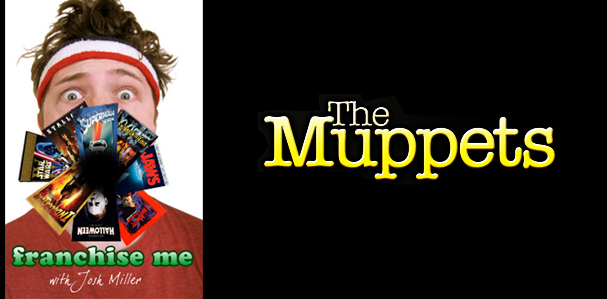
Hollywood loves a good franchise. The movie-going public does too. Horror, action, comedy, sci-fi, western, no genre is safe. And any film, no matter how seemingly stand-alone, conclusive, or inappropriate to sequel, could generate an expansive franchise. They are legion. We are surrounded. But a champion has risen from the rabble to defend us. Me. I have donned my sweats and taken up cinema’s gauntlet. Don’t try this at home. I am a professional.
Let’s be buddies on the Facebookz!
The Franchise: The Muppets — following the schtick-heavy misadventures of an eclectic race of puppet-like beings who thrive and survive amongst us in the regular human world. Birthed in the mid-1950’s by puppeteering super-champ Jim Henson for use in advertising commercials, the Muppet aesthetic/brand has since infiltrated every conceivable niche, medium and outlet imaginable, including television, music albums, motion pictures, video games, comic books, view finder stories, and literature. Since I imagine some may be disappointed to learn that I won’t be covering The Muppet Show, I figure an explanation is due… The reason is twofold: 1) While The Muppet Show is obviously where Henson’s Muppet creations solidified into the form we think of when we hear “the Muppets,” it was really just the culmination point of Henson’s success story; several of the central Muppets, like Kermit, Rolph and Gonzo, had already existed for many years by that point, as had the word “Muppet” to describe them. And more importantly, 2) TV is a can o’ worms. Why include that show and not Sam and Friends, Sesame Street, The Jim Henson Hour, Muppet Babies, Little Muppet Monsters, Muppets Tonight, etc, etc? And then there are the crazy number of TV movies and specials. It defeats the entire purpose of this column for me to pick and choose installments based on what I think is “good” or “relevant.” It is easier and frankly I think more interesting to boil the franchise down to something that is readily discussable — like the Muppets’ ventures onto the big screen. So, for the sake of tidiness, I will be battling the six theatrical feature films, plus the forthcoming The Muppets relaunch.
previous installments:
The Muppet Movie
The Great Muppet Caper
The Muppets Take Manhattan
The Installment: The Muppet Christmas Carol (1992)

The Story:
Not unlike Disney’s Aladdin (which oddly enough, competed against this film at the holiday box office in 1992), we open with a market place vendor breaking the fourth wall to address us directly and tell us a fantastical tale. Here it is Gonzo, identifying himself as Charles Dickens, and for some reason Rizzo the Rat too. Gonzo and Rizzo take us through Dickens’ classic tale of Xmas redemption, with Michael Caine as Scrooge, and our Muppet characters slotted in as various supporting characters. (I’m just assuming we all know the story of A Christmas Carol.) Kermit is Bob Cratchit. Piggy is Mrs. Cratchit. Kermit’s nephew Robin is Tiny Tim. Fozzie is Mr. Fezziwig (here Mr. Fozziwig; wacka wacka!). And Jacob Marley has been split into two characters, played by Statler and Waldorf.
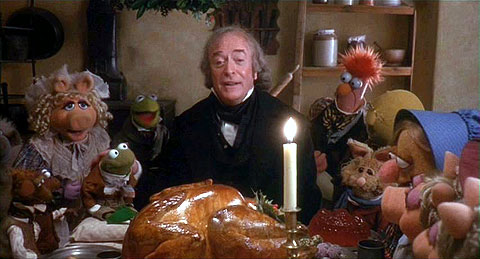
Before we actually get into any analysis, it’s time for everybody’s favorite game — contextualization!
This film marks two major milestones in the Muppet franchise timeline:
1) For those unfamiliar with Muppet history, either due to age or interest, Jim Henson died unexpectedly in 1990 of organ failure caused by Streptococcus pyogenes. (Personal side note: the shocking suddenness of his passing, and some inaccurate early reporting, caused a rumor to spread through my middle school that Henson died from common pneumonia because he was a Christian Scientist and refused to go to the doctor — something that pissed my friends and I off to no end; what a waste, we thought! Amazingly, I actually believed this to be true for nearly a decade until I began using the Internet. Henson was indeed raised by Christian Scientists, but he saw a doctor for his symptoms; he was just misdiagnosed and then his infection spread too quickly to be stopped once he went to a hospital. Anyway…) Forgoing an elegy of the too-soon passing of one of the most unique creative presences of the 20th-century, the context here is that The Muppet Christmas Carol marks the first post-Jim Henson Muppet film. Less impactful on the creative end, but no less notable in the performances, the film is also post-Richard Hunt, the Muppeteer responsible for Scooter, Statler, Beaker, Janice, and the giant Sweetums. Henson had been the voice of Waldorf, so here Statler and Waldorf are performed by Jerry Nelson and Dave Goelz — both characters sound noticeably different, but just as humorously malicious as ever.
2) This is the first Disney-era Muppet film. Disney, who have owned the Muppets outright since 2004, co-produced and distributed this film with the Jim Henson Company.
Context complete!
What Works:
So how do we judge The Muppet Christmas Carol? As a Muppet movie? As a Disney movie? As an adaptation of Charles Dickens’ A Christmas Carol?
There have been so many adaptations of A Christmas Carol over the years that they have their own Wikipedia page. At this point artists and entertainers can really do whatever the hell they want with it and no one will care, because lovers of Dickens’ book already have scores upon scores of films to warm their hearts; not to mention I highly doubt anyone out there was first exposed to the work in book form. Dickens’ concept and major plot-points are part of our collective consciousness now. So, considering that this is an adaptation involving the Muppets and produced by Disney, one would be safe in assuming that this isn’t going to be the most faithful of adaptations. But oddly enough, it is. It’s actually one of the more faithful adaptations I’ve seen, as far as following the beats of Dickens, even including the detail that the Ghost of Christmas Present ages throughout the course of his “chapter.” A lot of the dialogue is lifted directly from the book, and Gonzo’s periodic narration even allows the film to keep choice bits of Dickens’ descriptive prose.
As an adaptation of A Christmas Carol, the film is a holly-jolly good time. I love all the models used to create the heightened-reality fairytale ambiance of Dickens’ England. And John Fenner’s cinematography. Michael Caine is Michael Caine, so of course he is good, even if he is somewhat too charming and inherently likable to make an ideal Scrooge. As a Jim Henson’s Creature Shop production, the film’s sexiest achievement is the design and execution of the Three Ghosts of Christmas who guide Scrooge on his evening journey through past, present and the gloomy times yet to come. Christmas Future is the standard Grim Reaper-esque figure we’ve seen in a million different adaptations, but Christmas Past and Present are both neat to see Hensonized, with Present probably the most effective, considering that Past is a special effect, while Present is a dude in a suit wandering around on the set with Michael Caine. But all three character are representative of where Jim Henson had been moving his company and creations since Muppets Take Manhattan in 1984. The ethereal Ghost of Christmas Past feels like something from the creepier Labyrinth region of the Henson Company.

As a Muppet movie the film succeeds in a few areas too. Finally Paul Williams was brought back to write us some songs! “Scrooge,” the film’s opening number – a classic ‘getting to know the town’ number, as I’d call it – is a contained chunk of Muppet excellence, featuring scores of familiar Muppets (including Sprocket the dog from Fraggle Rock; among other ‘cameos’), and displaying the kind of fun Muppet gags we want from a Muppet movie. My favorite being a fruit cart full of Muppet fruit; when a thief grabs one it cries out, “Hey, I’m being stolen! Help me!” Elsewhere in the film, the rats from Muppets Take Manhattan are put to good use as Scrooge’s bookkeepers. It was great to finally see Sam the Eagle get showcased (here as Young Scrooge’s teacher). There is a great bit of Animal in the Fozziwig scene, where our woman-loving maniac is reduced to playing the triangle in some quaint and proper Victorian piece, and we see it slowly driving him nuts until he can’t take it anymore and freaks out on the drums, which immediately cues the rest of the band to play a jaunty dance tune. Though we’re completely “off canon” in Muppet Christmas Carol, I nonetheless liked seeing Kermit and Piggy’s children, who aren’t frog-pig hybrids, but rather frogs and pigs (boys being frogs, girls being pigs). The choice to make the girls aggressive, just like Piggy, was a smart move and allowed for a lot of humor in the Cratchit’s home scenes, as Kermit continues to be overpowered by the pig women in his life. And making Statler and Waldorf the Jacob Marley character was an inspired move. One the film frankly needed more of.
Just so we’re all on the same page, The Muppet Christmas Carol is entirely enjoyable and good family film. As a family Christmas film it is great. But…
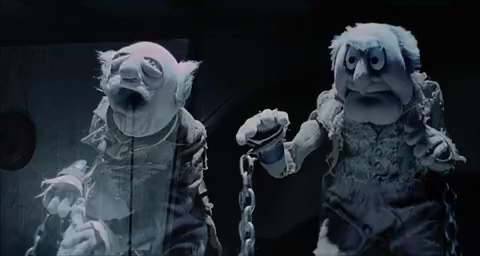
What Doesn’t Work:
…as a Muppet film it is unacceptable.
The Muppet Christmas Carol isn’t so much a Muppet movie as it is a movie with the Muppets in it. If all you want out of the Muppets it to see/hear them on screen, then this can presumably be seen as a worthy effort (considering that the film is pretty good). And this was surely an introduction to the Muppets for a whole generation of kids who had been too young or too not-born-yet to see any of the previous Muppet films (though this did coincided with The Muppet Show‘s syndication on TNT). But for the existing audience who had been following the franchise already, Carol is an almost sacrilegious misuse of the Muppet characters.
I have talked with people that feel like they shouldn’t have made any more Muppet films after Jim Henson died. Or that they at least should’ve retired Henson’s characters, especially Kermit. That first sentiment is pretty insulting to the rest of the Jim Henson Company, who were comprised of very creative individuals. Of course they should’ve kept making Muppet movies. As for the second sentiment, I don’t think anyone is going to argue that Steve Whitmire’s Kermit is as good as Jim Henson’s Kermit. I don’t think Steve Whitmire would argue that. But Kermit isn’t Lionel Hutz or Troy McClure. They couldn’t retire him. He’s the face of the franchise. And Whitmire’s Kermit isn’t bad. It’s just different. I think it was entirely within the Henson Company’s powers in 1992 to make a good Muppet film. But the ball was fumbled. Muppet Christmas Carol is a good movie, but three major problems keep it from being a good Muppet movie.
1) Our protagonist isn’t a Muppet.
For Disney this film is something of a remake. In 1983 Disney released Mickey’s Christmas Carol, which had the exact same gimmick as Muppet Christmas Carol — do Dickens with Mickey and friends. Like this film, Disney’s flagship character, Mickey, was used as Bob Cratchit instead of Ebenezer Scrooge. Makes sense. Could you really imagine Mickey as Scrooge? Instead Disney resurrected one of its greatest characters, Carl Bark’s Uncle Scrooge, to play the part (it was such a successful resurrection actually, that Disney gave Uncle Scrooge his own TV show afterwards, DuckTales). By placing a human in the role of Scrooge in our Muppet adaptation, the entire Muppet system is thrown out of whack. We aren’t seeing the Muppets’ story anymore, we’re seeing Michael Caine’s story; the Muppets are just their to service his narrative. Statler and Waldorf, or Sam the Eagle, have personalities that suit Scrooge, but they’re too one-dimensional to play a lead. I think Kermit should’ve been Scrooge. After all, Scrooge is a character who is good at heart, but who was made hard and bitter through circumstance, and then becomes good again. Mickey Mouse is a boring cipher, whose level of fame was entirely manufactured and thrust upon the world by Disney as a branding tool. I don’t think Disney could’ve pulled off a good Mickey as Scrooge. Kermit on the other hand is a great character. He’s versatile and flawed. A Kermit Scrooge could have been really interesting (especially if they had strayed from Dickens’ story in places). Honestly, I think this film was somewhat doomed from the moment the decision was made to make Scrooge human, but the filmmakers could have pulled out of this skid had they not also done the following two problems…
2) The Muppets aren’t playing themselves.
Caper showed us that we could break away from stories about the Muppets being performers, as long as they retained their tried and true personalities and inter-group dynamics. Carol completely does away with this good sense. Some characters are fitted into the story well – Statler & Waldorf, Sam the Eagle, Miss Piggy – but most are not. If the film had strayed farther from Dickens original tale, I could imagine Kermit making a great Bob Cratchit, as he is well-suited for the voice of reason. But Dickens’ Cratchit is a white-bread lame duck who lives completely at the mercy of Scrooge, who gets a happy ending only because Scrooge changes his ways; a change that Cratchit has little to directly do with. That was okay for Mickey Mouse, but this is Kermit the Frog we’re talking about. Cratchit is meek and insecure, kind of pathetically subservient and worshipful to Scrooge; a side kick. Does that remind you of any famous Muppet? Fozzie, maybe? Fozzie should’ve been Cratchit. He plays Fozziwig entirely because his name made for a good joke, a joke kids weren’t going to pick up on anyway.
We get Fozzie, but we don’t get Fozzie. Fozziwig isn’t like Fozzie. He doesn’t tell jokes, and he easily commands a room full of friends and family in his only scene. Frankly, Fezziwig seems better suited for Kermit (not that this would’ve been a good use of Kermit either). And while I loved seeing Bunsen and Beaker get so much screen time after being sadly underused in the past two films, in reality they’re underused once more here playing charity collectors. Where are the inventions? Why isn’t Beaker getting blown up or otherwise abused? Why even have them as these characters? Considering the meta tone the Muppets usually have, it seems like we should get the impression that the Muppets are acting in these roles; especially Fozzie, who should’ve broken character to tell a joke or something. Only Statler and Waldorf and Sam the Eagle have this tone (both have funny meta jokes), which is extra confusing as it shows that the filmmakers understood all this, but chose to largely ignore it. But Bunsen, Beaker, Kermit, Fozzie and the rest feel spot on compared to…
Gonzo.
What the hell happened to Gonzo? Watch this back-to-back with Caper (Gonzo at his best, I’d say) and it is hard to believe Dave Goelz was still involved with the character. It was a funny idea to have a narrator addressing the camera throughout the movie, and having it be Gonzo could have worked. But this doesn’t feel like Gonzo. Gonzo’s charm has always come from how un-self-aware he is. He’s an oddball, and is generally best used as a button gag to scenes, where he’ll add something bizarre and often tangential to a conversation. Why pair him with Rizzo the Rat? I have to assume Disney and the Henson Company felt Rizzo had become a popular character, given that he has more screen time in the film than Fozzie or Piggy or possibly even Kermit. Rizzo was funny in Manhattan, but based on his use in Carol, I’m not entirely sure what his thing is. Paired with Gonzo, Gonzo becomes the straight man. Who didn’t think that seemed unnatural — Gonzo the straight man? Here he’s the Abbott to Rizzo’s Costello. Gonzo has the slow burns. Rizzo is the wacky one. There is even a point when Gonzo says to Rizzo, “You are such an idiot.” Now Gonzo is the smart one too! More so than this being a Muppet purist complaint (cause, hey, if it works than whatever), I just didn’t find the combination of these characters funny. Rizzo isn’t a great Muppet, and though the duo have a few funny bits, they aren’t nearly funny enough for how much screen time they get. If Kermit couldn’t be Scrooge, he should have been the Dickens narrator. That would’ve fit perfectly with Kermit’s role as our portal to the Muppet world, always giving us asides. And he would have had more screen time too. As it is, it feels like Rizzo is being forced on us, which just seems odd considering all the better Muppets that are pushed aside. Speaking of Muppets being pushed aside…
3) The Muppets aren’t playing enough important characters.
Why aren’t the three Ghosts of Christmas played by existing Muppets? (In Mickey’s Christmas Carol the three ghosts are played by Jiminy Cricket, Willie the Giant, and Pete.) According to the interwebs this decision was made because the filmmakers worried that audiences wouldn’t be able to take the story as seriously if Rowlf or Dr. Teeth were guiding Michael Caine along his journey. To which I say, why the fuck do we need to take it seriously? Isn’t this a Muppet movie? It is not exactly like the world need another Christmas Carol adaptation. As I said, the ghosts are cool, but correct me if I’m wrong, this movie is called The Muppet Christmas Carol not The Jim Henson Creature Shop Christmas Carol. Richard Donner’s Scrooged effectively demonstrated that a Dickens’ adaptation can be played for wacky laughs and still resonate in the emotional moments. Plus, Statler and Waldorf already set the precedent for the movie. Their scene is entirely played for laughs. It it is great. The door has been opened. Why stop there? There are so many great Muppets to choose from that could have lent fun tweaks to the ghosts. How about Dr. Teeth and the Electric Mayhem as the collective Ghost of Christmas Present? Fozzie as the Ghost of Christmas Past, telling horrible jokes the whole time? Scrooge’s nephew also should have been a Muppet.
All-in-all, Carol wastes the Muppets. When it hits its mark, it is great, which only serves to highlight how often it is getting things wrong. Making a Christmas Carol with the Muppets is a valid concept, but possibly staying so faithful to Dickens was a mistake in itself. And having Brian Henson (Jim’s son) direct the project makes a lot of sense, as he was heir to the throne. But I wish Frank Oz had shepherded this film. He was still at the height of his comedy-directing game (coming off of Dirty Rotten Scoundrels and What About Bob?), and directing this would have kept him from making HouseSitter.
This isn’t something that “doesn’t work” but… It was a great idea to finally bring Paul Williams back, though he doesn’t seem as naturally suited to the kinds of songs Carol needs as he was to The Muppet Movie. The first film came out in the 70’s, and the music was an eclectic blend of pop, rock and folk styles of the time. Now Williams is being asked to craft pieces more akin to show tunes, which doesn’t play as well to Williams’ style. The one tune that feels like classic Williams is a bouncy a cappella duet between Kermit and Robin, but it last for about twenty seconds. I would have loved to see it expanded into a whole song.
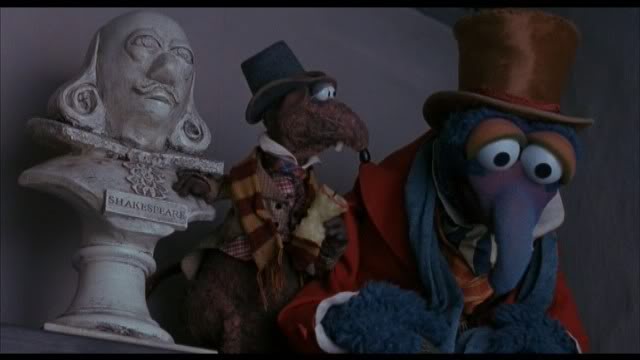
Celebrity Cameo Count: None.
Best Celebrity Cameo: Didn’t you hear what I just said?! Jeez.
Best Pun:
Ebenezer Scrooge: There’s more gravy than of grave about you.
Robert Marley: More gravy than of grave?
Jacob Marley: What a terrible pun. Where’d you get those jokes?
Robert Marley: Leave comedy to the bears, Ebenezer.
Worst (aka Best) Fozzie Joke: Not applicable.
Most Ridiculous/Bizarre Joke: Not applicable.
Best Meta Moment/Line:
Sam talking to Young Scrooge.
Sam the Eagle: You will love business. It is the American way!
Gonzo, concerned, whispers into Sam’s ear.
Sam the Eagle: Oh… It is the British way!
Joke No Child Could Understand: Statler is Jacob Marley, while Waldorf is the newly created Robert Marley; in other words Bob Marley.
Sadly Under-Featured Muppet: Most of them.
Should There Have Been a Sequel: Not like this. But yes, the characters are still hot, no reason to let a bump in the road end the journey.
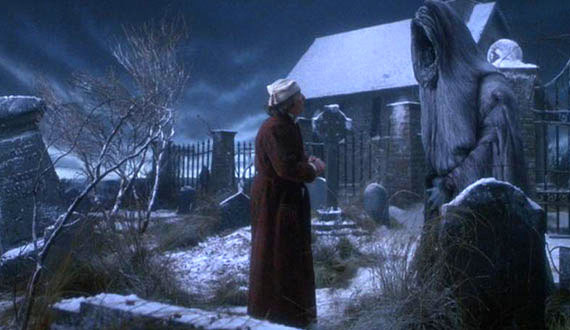
Up Next: Muppet Treasure Island
DISCUSS THE FRANCHISE ON THE BOARDS
previous franchises battled
Critters
Death Wish
Hellraiser
Leprechaun
Phantasm
Planet of the Apes
Police Academy
Rambo
Tremors